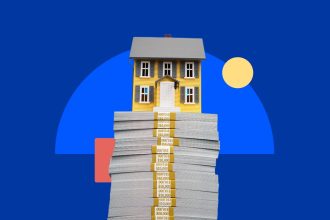Weekend Images Inc./Getty Images; Illustration by Austin Courregé/Bankrate
Mortgage lenders commonly require that borrowers maintain a homeowners insurance policy on their home. Depending on how the timing lines up with closing on the property and completing the home insurance paperwork, there could be a gap after buying the home wherein the insurance policy would still be going through underwriting and hasn’t been issued yet. To ensure your home is protected during this window and to provide proof of coverage to your mortgage lender, your insurer can provide you with a homeowners insurance binder. Using extensive industry experience and a team including licensed insurance agents, Bankrate explains what a homeowners insurance binder is, when you need one and how to secure one.
What is a home insurance binder?
A homeowners insurance binder is a type of temporary contract between the homeowner and the insurance company. This contract provides immediate yet temporary coverage for the home in situations where the full homeowner insurance policy would not be in force due to underwriting or other delays. These temporary contracts are often set to last between 30 and 90 days but will also expire once the full policy is issued.
The insurance company may automatically issue a homeowners insurance binder after you finalize the application. If not, you can request a binder from your insurance agent or the company. It usually contains one or two pages of essential information about your policy, like the effective and expiration dates, named insurance information, coverage levels and property address.
Do I need a home insurance binder?
Lenders often request proof of homeowners insurance before they will approve a mortgage loan. The lender will typically provide a list of documents they require for the underwriting process and the timeline you need to provide them, which is determined by your closing date.
It may take some time to receive your policy documents after you purchase a home insurance policy, so a home insurance binder may provide the proof of coverage that your lender needs in order to approve your mortgage. A binder also enables you to file a claim should there be a covered incident that occurs before you receive your policy documents.
However, not all companies issue home insurance binders. Insurance providers that use advanced technology such as artificial intelligence tools to underwrite policies can typically issue homeowners policy documents online, usually within a few hours, and that same-day policy document delivery typically eliminates the need for an insurance binder.
What does a home insurance binder include?
An insurance binder serves as your proof of home insurance coverage, so it must contain detailed information. This typically includes:
- Property address
- Policyholder’s name
- Insurer details, including the name of the insurance company and insurance agent
- Types of protections, like dwelling, personal property, loss of use, personal liability and medical payments coverages
- Coverage limits
- Policy deductibles
- Covered perils, such as fire, hail and wind
- Effective dates, including when the coverage begins and ends
How to get a home insurance binder
If your insurance company does not automatically issue a home insurance binder, you can typically request one using the following steps:
- Review the documents you receive after completing your homeowners insurance application.
- If the binder is not included, contact the insurance agent or company to request a binder.
- You should be able to receive the binder immediately via email, fax or by downloading it from your online account. It might also be mailed to you or the lender. You may be able to obtain a copy of the binder from your agent.
- At your request, the binder can also be electronically transferred to the mortgage lender or other interest requesting the binder.
Since the binder is temporary, you may need to provide a copy of the policy declarations page or other finalized documents once the policy is issued. You can download the policy documents online or request them the same way you requested the homeowners insurance binder.
Frequently asked questions
-
-
You can usually get a home insurance binder immediately after requesting it. You may be able to receive it via email, fax or download it in your online account. If you do not need the homeowners insurance binder immediately, you can request it be mailed to you.
-
One of the most common reasons to need a home insurance binder is to provide proof of insurance to your lender as part of the underwriting process for a new mortgage or refinance. The homeowners insurance policy has to also go through an underwriting process, which can take days or weeks to complete. The binder serves as temporary proof of insurance coverage to satisfy lender requirements so you can close on your house without delaying the process while the insurance company completes its underwriting process.
-
Yes, a home insurance binder can be canceled by your insurer if your coverage application ends up being denied. A home insurance binder is a temporary agreement between you and an insurance provider that provides coverage until a formal insurance policy is issued. Since it’s a temporary arrangement, it can usually be canceled by either party. However, the specific terms and conditions regarding cancellation, including any potential fees or penalties, will be detailed in the binder agreement. It’s important to review these terms carefully and communicate with your insurance provider to ensure you don’t end up with a lapse of coverage.
-
Declaration pages are a component of your full homeowners insurance policy and are not included in homeowner insurance binders. These pages summarize the entirety of your coverage under that policy and include key details about your plan, such as your policy number. Insurance binders serve as temporary contracts that provide proof of coverage until your homeowners policy goes into force and do not include a declaration page.
-
Read the full article here
















